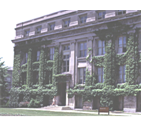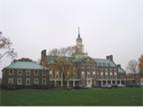 The website is in construction. New files will be uploaded as soon as they are available.
The website is in construction. New files will be uploaded as soon as they are available.
DEANE MONTGOMERY
Weaver, Minnesota 1909 - Chapel Hill, North Carolina 1992

- Brief scientific biography
- Contributions to Education
- Relevant bibliography
- Publications on the teaching of mathematics
Brief scientific biography

Hamline University

MacLean Hall,
University of Iowa
University of Iowa
In 1935, Montgomery was appointed assistant professor at Smith College. He was promoted to associate professor in 1938 and then full professor in 1941.

Fuld Hall, Institute for Advanced Study
At the Institute, Montgomery was at the center of activity in topology, running the topology seminar for many years. Early in his career, his research interests had shifted from point-set topology to topological transformation groups. For example, in one of his early papers (MONTGOMERY, 1937), he proved that a pointwise periodic self-map of a manifold is periodic. In collaboration with Leo Zippin, he published a series of papers on the linearizability of group actions on low-dimensional manifolds (e.g., MONTGOMERY & ZIPPIN, 1940). Montgomery and Zippin were especially interested in Hilbert's Fifth Problem:

"A connected locally compact group G is a projective limit of a sequence of Lie groups; and, if G has no small subgroups, then it is a Lie group".In 1948, Montgomery and Zippin solved the problem for three dimensions and by 1952 had solved it under the assumption of finite dimensionality. Later that year, Montgomery's assistant Yamabe was able to remove that restriction, and in 1955, in collaboration with Zippin, Montgomery published the monograph Topological Transformation Groups. He continued to work on transformation groups, studying with a variety of collaborators such groups and their relations to surgery theory.
Until he retired in 1980, Montgomery remained at the Institute. In 1988, he and his wife moved to Chapel Hill, North Carolina, to be near their daughter and their two granddaughters, all of whom survived him when he died on 15 March 1992.

Montgomery served on the Executive Committee of the International Mathematical Union from 1963 to 1966. He was vice-president of the IMU from 1967 to 1970 and president from 1975 to 1978. From 1975 to 1978, as IMU president, he was also an ex officio member of the International Commission on Mathematical Instruction
Contributions to education
As a teacher and mentor, Montgomery was known for his efforts to help young topologists and for his interest in the careers of students from graduate programs at smaller institutions. He would seek out and encourage visitors to the Institute, particularly young mathematicians, conducting seminars in his office to acquaint them with recent developments in the field.
Montgomery was one of 65 mathematicians who signed the 1962 article, "On the Mathematics Curriculum of the High School", by Lipman Bers, Morris Kline, George Polya, and Max Schiffer, that criticized some of the new math curriculum efforts for being too abstract and formal. The article offered "fundamental principles and practical guidelines" for reforming the school mathematics curriculum, arguing that anyone attempting reform needed to link school mathematics more closely to its history and to concrete applications so that future nonmathematicians would not be turned away. He was not one of the writers of the article, but he obviously supported the argument
Relevant bibliography
D. MONTGOMERY 1937, Pointwise periodic homeomorphisms, American Journal of Mathematics, 59, 118-120
D. MONTGOMERY, L. ZIPPIN 1940, Topological group foundations of rigid space geometry, Transactions of the American Mathematical Society, 48, 21-49
D. MONTGOMERY, L. ZIPPIN 1955, Topological transformation groups, New York, Interscience
Bibliography of Deane Montgomery 1985, Contemporary Mathematics, 36, 13-16
A. BOREL 1992, Deane Montgomery (1909-1992) , Notices of the American Mathematical Society, 39, 7, 684-686, reprinted in 1993 in the Proceedings of the American Philosophical Society, 137, 3, 452-456
R. FINTUSHEL 2005 (March), A tribute to Deane Montgomery, Notices of the American Mathematical Society, 52, 3, 348-349
1988 Steele Prizes awarded at centennial celebration in Providence 1988, Notices of the American Mathematical Society, 35, 7, 965-970
F. RAYMOND, R. SCHULTZ 1985, The work and influence of Deane Montgomery, Contemporary Mathematics, 36, 1-11
W. SAXON 1992 (March 18), Deane Montgomery is dead at 82; taught theoretical mathematics, The New York Times, p. D22
Publications on the teaching of mathematics
L.V. AHLFORS et al. 1962, On the mathematics curriculum of the high school, American Mathematical Monthly, 69, 189-193, and Mathematics Teacher, 55, 191-195
Author
Jeremy Kilpatrick
University of Georgia
jkilpat@uga.edu
